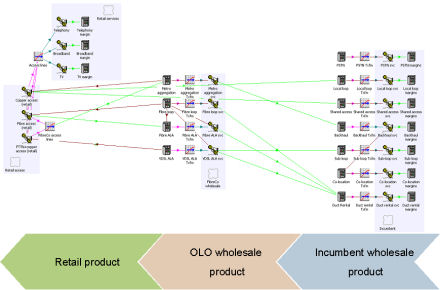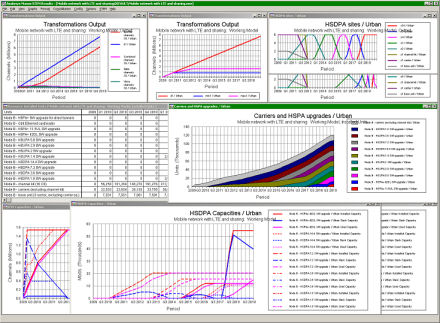 The 14th
Annual STEM User Group Meeting was held in September at King’s College, Cambridge,
and was attended by 18 delegates from Chemnitz University of Technology, Fairway
Associates Ltd, Nokia Siemens Networks, Rynton Technology Consultants, Sky Network
Services, Telekom Srbija, Telkom South Africa, The PSBA Network, T-Mobile, Ventura,
plus several independent consultants. Participants enjoyed an interesting mix of
consulting presentations on LTE evolution, mobile broadband, and duct sharing, plus
the launch of STEM version 7.2, discussion of a variety of applications (HSPA upgrade
modelling, activity-based costing, bandwidth aggregation), and our vision for an
online hosted version of STEM.
The 14th
Annual STEM User Group Meeting was held in September at King’s College, Cambridge,
and was attended by 18 delegates from Chemnitz University of Technology, Fairway
Associates Ltd, Nokia Siemens Networks, Rynton Technology Consultants, Sky Network
Services, Telekom Srbija, Telkom South Africa, The PSBA Network, T-Mobile, Ventura,
plus several independent consultants. Participants enjoyed an interesting mix of
consulting presentations on LTE evolution, mobile broadband, and duct sharing, plus
the launch of STEM version 7.2, discussion of a variety of applications (HSPA upgrade
modelling, activity-based costing, bandwidth aggregation), and our vision for an
online hosted version of STEM.
 Clients
were very complimentary about the event, which featured a punting lunch outing on
day one (the sun even shone!) and a tour of the sublime King’s College chapel
on day two. What better metaphor could there be for the contrast between our established
modelling process and the alternative, ad hoc spreadsheet bazaar?
Clients
were very complimentary about the event, which featured a punting lunch outing on
day one (the sun even shone!) and a tour of the sublime King’s College chapel
on day two. What better metaphor could there be for the contrast between our established
modelling process and the alternative, ad hoc spreadsheet bazaar?
Delegates welcomed the combined consulting and STEM content, as well as the outline
of a future STEM Online. The showcase of various existing applications provoked
easily as much insightful discussion as the live modelling exercises we have done
in the last years – perhaps preparation yields better overall results for
the audience than spontaneity in this context? The Wake-up training session on activity-based
costing in particular seemed to open eyes to broader possibilities beyond
the more commonly understood applications such as scenario analysis and capex planning.
“Thank you for an excellent event – enjoyed seeing the potential of STEM,
enjoyed the unique and kind hospitality and talking with other current/candidate
STEM users. All in all a fabulous and very informative/stimulating 2 days.”
— Integrated service provider
The agenda, dates and location for the 2010 event will be announced in our April
2010 newsletter.
The strategic consulting track
Lee Sanders (Partner) kicked off the first session with a talk entitled The shape
of a mobile network model in the era of LTE and network sharing.
Lee’s talk explained current challenges and trends for mobile, examined strategies
for future LTE deployment as an alternative to sweating existing 3G assets, and
reviewed the benefits of network sharing in light of existing precedents. (See also
HSPA upgrade model mentioned below.)
Robert Schumann (Lead Consultant) presented a session examining The true cost of
mobile broadband. Many operators we have spoken to believe that mobile
broadband is at the very least difficult to monetise. After reporting on current
industry trends, Robert explored what, in the bits, noise and heartbeats, determines
cost; and what, be it bytes, time or access, determines profit. Finally, he provided
a quick look at a STEM model of mobile broadband services which can be plugged into
the infrastructure model being developed by Robin.
Robert presented a wholly different topic on day two entitled Opening the ducts:
a STEM value chain model. Many incumbent operators in Europe face the threat
of having their ducts opened to competitors. The questions are, ‘Will anyone
actually want to buy our ducts on a large scale, to support a deployment of a next
generation access (NGA) network?’ and if so, ‘What will that do to our
revenue and profit?’ Robert rattled through the basics of next generation
access and explored some of the regulatory strategy issues which we are
working on at the moment. Finally, he presented a STEM model which captures the
incumbent wholesale/OLO wholesale/retail value chain.

Incumbent wholesale/OLO wholesale/retail value chain
The STEM applications and features track
Robin Bailey, the event host, opened the meeting with an address entitled Understanding
the changing audience for STEM, exploring inter-weaving themes of software
ergonomics, changing platforms and user expectations, and the importance of meeting
end-user requirements in parallel with those of the more directly vocal modelling
experts.
Robin is responsible for a new work-in-progress reference model examining the evolution
of an existing 3G operator through successive HSDPA, HSUPA and HSPA+ capacity
upgrades, and ultimately migration to LTE. This model will be used to evaluate some
of the strategic options outlined in Lee Sander’s earlier talk. Robin
talked through the scope of this model, and explained in detail a new technique
for simulating the geo-graphical distribution of phased capacity upgrades.

R99 and HSPA-upgrade deployment
Robin presented the final feature set for STEM version 7.2 in its formal
launch to customers, and explained how new interface metaphors, text boxes and export
tools will make the new version easier to learn , and then to use, and to hand over
to colleagues – see separate
article.
Robin also later presented our Future vision for STEM: connecting users and ideas.
STEM as a desktop application delivers almost unlimited modelling power, from a
quick business-case sprint in an afternoon, through to elaborate and extensive network
modelling exercises involving thousands of elements. But the outputs from STEM may
not look very different to Excel; so the end user (who is usually paying) may wonder
what all the fuss is about. Now we are considering creating an application portal
website as an online environment and experience for STEM which would provide immediate
access, anywhere, with nothing to install (‘software as a service’), and an online
results browsing experience that would better engage the end user.
On day two, Robin presented a Wake-up training session on activity-based costing,
raising the profile of STEM’s intrinsic and holistic cost-allocation mechanism
by walking through the Mobile
network activity-based cost model mentioned in our July 2009 newsletter.
As further awareness raising, Robin later explained How to model bandwidth aggregation
and core networks by talking through a
two-tier aggregation architecture (using template replication) which
can be used to map forecast demand onto area- or street-level deployment without
creating impossibly large (that is, unmanageable) spreadsheets! Such techniques
are going to be vital as the majority of operators assess strategic options for
FTTH over the next decade.
In the final Modelling clinic session, some insights into the recent STEM
7.1b/c/d maintenance releases were provided, including various optimisations for
the Results program when handling very large models. Thomas Martin Knoll and Paul
Walther from Chemnitz University of Technology took this opportunity, as relatively
novice modellers, to present a work-in-progress STEM model which examines class-of-service
based IP-network interconnection. This model will be described in detail in our
January 2010 newsletter.
Photographic images: © 2009 Manfred Illenberger